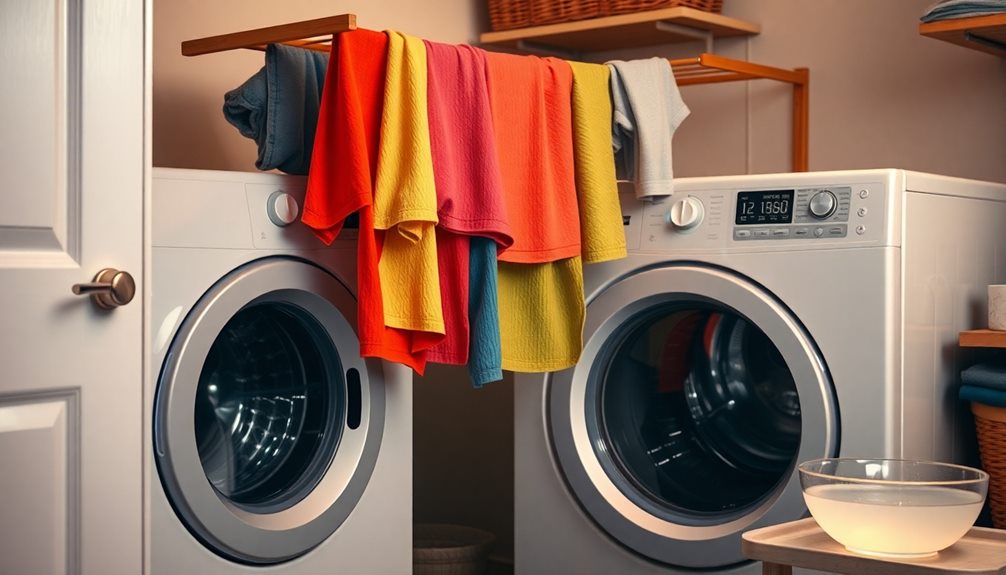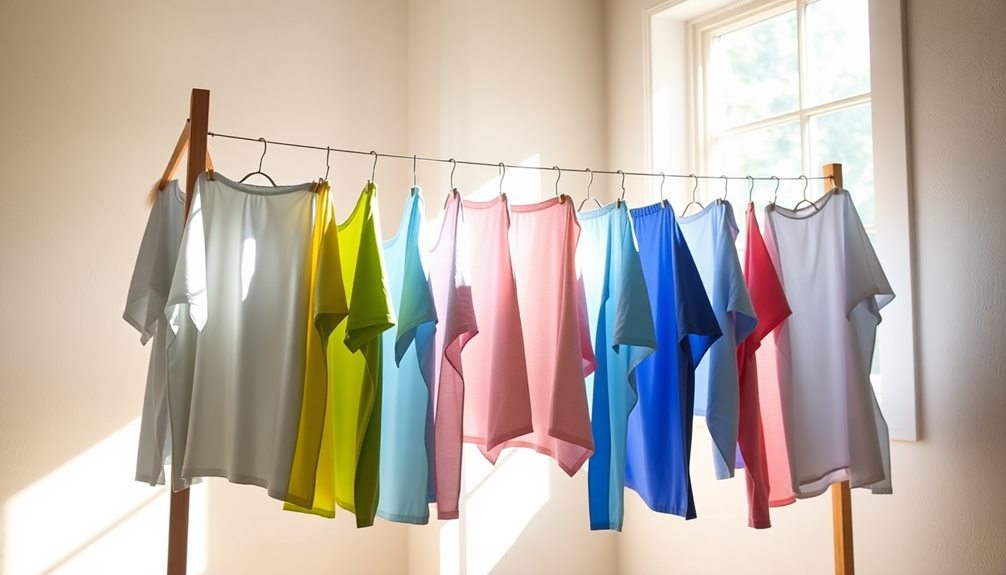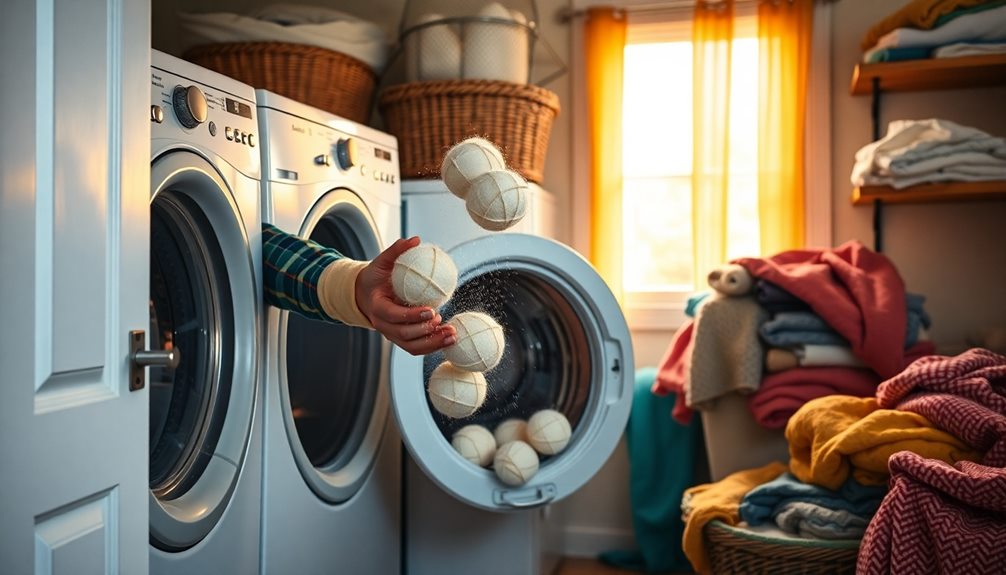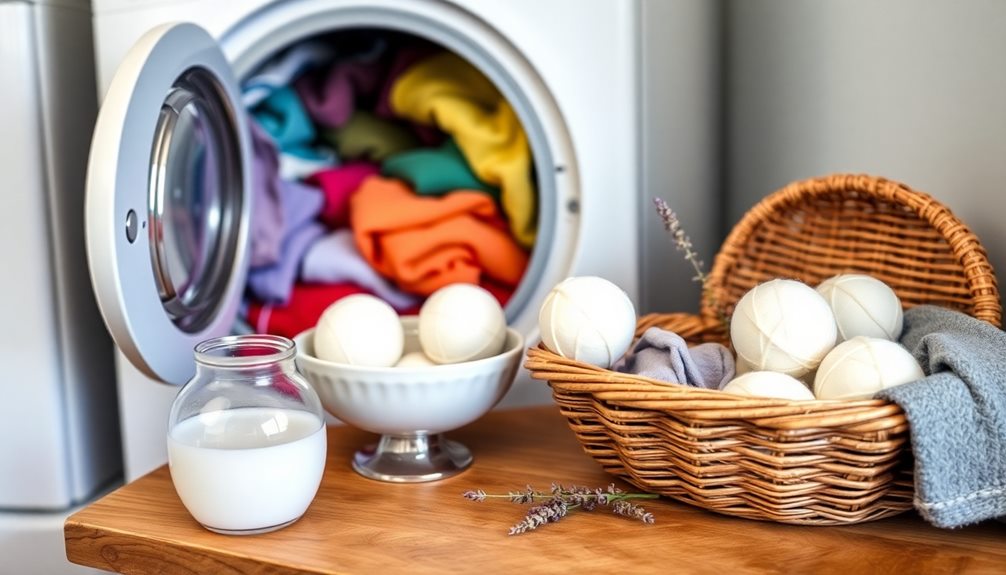To reduce static in your dryer without using dryer sheets, try adding ½ cup of white vinegar during the rinse cycle. You can also toss in wool dryer balls or crumpled aluminum foil balls to help absorb moisture and discharge static. Separating synthetic fabrics from natural ones minimizes friction and static buildup. Additionally, air drying your clothes can greatly reduce static while preserving their integrity. Adjusting your dryer settings to avoid over-drying will also help. If you're curious about more effective tips and methods, there's plenty more information to explore on this topic.
Key Takeaways
- Use wool dryer balls to absorb moisture and reduce static while fluffing clothes during the drying process.
- Add ½ cup of white vinegar to the rinse cycle to act as a natural fabric softener and reduce static cling.
- Crumple aluminum foil into balls and toss them in the dryer to help discharge static electricity from fabrics.
- Separate synthetic fabrics from natural fibers before drying to minimize static buildup caused by friction.
- Opt for air drying whenever possible to reduce friction, conserve energy, and maintain fabric integrity, which helps eliminate static cling.
Understanding Static Cling
Static cling often becomes a frustrating issue, especially after doing laundry. It occurs due to an imbalance of electrical charges that build up on your fabrics through friction during washing and drying. The triboelectric effect is the primary cause of this phenomenon; when certain materials rub against each other, they can become positively or negatively charged.
Synthetic fabrics like nylon and polyester are particularly prone to generating static cling, while natural fibers such as cotton and wool are less likely to produce it. You'll notice that on days with low humidity, static cling can be even worse, since moisture in the air helps dissipate those pesky electrical charges.
To tackle static cling effectively, try reducing static during the drying process. One quick solution is to touch a grounded metal object, which can help discharge any built-up static electricity from your clothing.
Additionally, consider mixing synthetic fabrics with natural fibers in your laundry to keep static at bay. By understanding the factors that contribute to static cling, you'll be better equipped to manage and reduce it in your dryer.
Natural Alternatives to Dryer Sheets

When it comes to reducing static cling in your laundry, natural alternatives to dryer sheets can be surprisingly effective. You don't need harsh chemicals to keep your clothes fresh and static-free. Here are some great options to reflect upon:
| Natural Alternative | Benefit |
|---|---|
| White Vinegar | Acts as a fabric softener and reduces static cling. |
| Wool Dryer Balls | Absorb moisture and minimize static while being eco-friendly. |
| Baking Soda | Softens clothes and balances pH to reduce static cling. |
| Aluminum Foil | Discharges static electricity when crumpled into balls. |
Using ½ cup of white vinegar in the rinse cycle can leave your clothes soft without unwanted odors. If you prefer a more hands-on approach, try making DIY dryer sheets by soaking fabric scraps in vinegar and essential oils. For a quick fix, toss crumpled aluminum foil balls into the dryer to help discharge static electricity. Finally, incorporating six or more wool dryer balls not only reduces drying time but also minimizes static cling. Embrace these natural methods to enjoy softer, static-free laundry!
Effective Drying Techniques

If you want to cut down on static, consider hang drying your clothes; it reduces friction and keeps your fabrics looking great.
When using the dryer, always separate synthetic fabrics from natural fibers to minimize static buildup.
These effective drying techniques can make a big difference in how your laundry feels when you take it out.
Hang Drying Benefits
Utilizing hang drying techniques not only helps eliminate static cling but also enhances the overall freshness of your laundry.
When you hang dry your clothes, you're taking advantage of natural air circulation, which reduces friction between garments and minimizes static buildup. Additionally, using methods that promote better indoor air quality can further enhance your laundry experience, as heat pumps and indoor air quality can guarantee a healthier environment for drying.
Here are some key benefits of hang drying:
- Lower energy consumption: Save on utility bills while being eco-friendly.
- Preserved fabric integrity: Avoid heat exposure that can harm your clothes.
- Maintained moisture balance: Slow drying helps keep the right moisture levels, further reducing static.
- Fresh air exposure: Enjoy the natural scent of outdoors while eliminating odors.
Synthetic Fabrics Management
Hang drying can effectively minimize static cling, but managing synthetic fabrics during the drying process is equally important. To start, always dry synthetic fabrics, like nylon and polyester, separately from natural fibers. This helps reduce static electricity since synthetic materials are the main culprits behind static cling.
Additionally, utilizing smart home device integration can help streamline your laundry routine by allowing you to monitor your dryer settings remotely.
To further reduce drying time, keep an eye on your dryer and stop it when clothes are just dry. This prevents over-drying, which can worsen static cling. When setting your dryer, opt for lower heat settings specifically for synthetic fabrics to avoid damage and mitigate static buildup.
Incorporating aluminum foil balls into the dryer can make a big difference. These balls effectively discharge accumulated static electricity, helping to keep your clothes static-free.
Additionally, consider using wool dryer balls with your synthetic loads. They absorb moisture and maintain a humid environment inside the dryer, further reducing static without relying on chemical softeners.
Using Household Ingredients

Using common household ingredients can effectively reduce static in your dryer, making laundry day a little easier. Here are some simple solutions to try:
- Add ½ cup of white vinegar during the rinse cycle to act as a natural fabric softener and static reducer.
- Toss crumpled aluminum foil balls into the dryer to absorb excess static electricity.
- Mix in ½ cup of baking soda to soften fabrics and keep colors bright while reducing static cling.
- Use wool dryer balls to fluff clothes and maintain humidity, which helps minimize static buildup.
These household ingredients not only help to reduce static cling but also keep your laundry fresh without harsh chemicals.
For a quick fix, touch a metal object, like a hanger, before handling your clothes to discharge any accumulated static electricity.
With these easy tips, you can enjoy a more pleasant laundry experience and keep those pesky static shocks at bay.
Give these methods a try, and you'll notice a significant difference in your freshly dried laundry!
Benefits of Air Drying

Air drying your clothes offers several benefits that you mightn't have considered.
Not only does it help eliminate static cling by reducing friction, but it also conserves energy, saving you money on utility bills.
Plus, this method preserves the integrity of your fabrics, extending their lifespan and keeping them looking great.
Energy Conservation Benefits
Opting for air drying your clothes not only cuts down on energy consumption but also helps your wallet. By skipping those energy-intensive dryer cycles, you can enjoy several benefits:
Wood-burning stoves, much like air drying, provide an efficient heating solution that reduces energy use and costs. This approach to energy conservation mirrors the economic benefits of wood-burning stoves, which can lead to even greater savings in your home.
- Lower utility bills: Save about 3-4% on your energy bill for every load you air dry.
- Energy conservation: Reduce overall energy consumption in your home.
- Save on clothing costs: Extend the lifespan of your fabrics, leading to less frequent replacements.
- Decrease greenhouse gas emissions: Contribute to a greener planet by minimizing the carbon footprint of your household.
Air drying is a simple yet effective way to make a positive impact. By utilizing indoor or outdoor drying options like clotheslines or drying racks, you could save an average of $100 per year on energy costs associated with laundry.
Plus, avoiding the dryer helps reduce wear and tear on your clothing, keeping them looking newer for longer. With these energy conservation benefits, you'll not only enjoy lower utility bills but also feel great knowing you're making a difference for the environment.
Start air drying your clothes today, and watch the savings stack up!
Fabric Longevity Preservation
Choosing to air dry your clothes not only benefits the environment and your wallet but also plays a notable role in fabric longevity. By opting for air drying, you considerably reduce friction between fabrics, which helps minimize static cling without the need for fabric softener or dryer sheets. This gentle method preserves the integrity of your natural fabrics, maintaining their fit and preventing the degradation of elastic fibers that often occurs in high-heat dryers.
Moreover, air drying allows your clothes to retain their natural moisture content, preventing brittleness that leads to wear and tear. You'll also notice that colors remain vibrant, as the risk of fading and damage is greatly reduced compared to the harsher conditions of a dryer.
Here's a comparison of air drying benefits versus traditional drying:
| Aspect | Air Drying | Traditional Drying |
|---|---|---|
| Friction | Reduced | High |
| Elastic Fiber Health | Maintained | Degraded |
| Moisture Retention | Better | Poor |
| Color Preservation | Enhanced | Faded |
Static Cling Elimination
Static cling can be a frustrating issue when doing laundry, but you can easily eliminate it by air drying your clothes. This method not only reduces the friction that generates static electricity but also preserves the integrity of your fabrics.
Here are some key benefits of air drying:
- Minimizes static cling effectively
- Preserves fabric lifespan by preventing wear and tear
- Reduces energy consumption and lowers utility bills
- Enhances moisture retention, combating static buildup
When you air dry, you avoid the tumbling action of a dryer that often contributes to static cling. Instead, hanging your laundry allows for natural moisture retention, which is especially beneficial during high-humidity seasons.
The added moisture in the air helps keep your fabrics from becoming too charged.
User Experiences and Tips

How can you tackle the pesky problem of static cling in your dryer? Many users swear by crumpling aluminum foil into balls and tossing them in with your laundry. This simple trick helps discharge accumulated static electricity, effectively reducing static cling.
Another popular method is using wool dryer balls. They not only help reduce static but also absorb moisture, creating a more humid environment that minimizes static buildup.
You might also want to separate synthetic fabrics from natural ones during drying. Synthetic materials are more prone to accumulating static electricity, so this separation can make a noticeable difference.
Additionally, adjusting your drying time is essential—over-drying clothes increases static due to excessive friction. Aim to take your laundry out while it's still slightly damp.
Some users have found that touching metal objects, like a metal hanger, before putting on clothes provides a quick discharge of static electricity, alleviating cling temporarily.
Frequently Asked Questions
How to Get Rid of Static in Dryer Without Dryer Sheets?
To get rid of static in your dryer, try crumpling aluminum foil into balls, adding wool dryer balls, or using vinegar in the rinse cycle. Also, avoid over-drying and separate synthetic fabrics from natural ones.
What Is the Best Alternative to Dryer Sheets for Static?
While dryer sheets promise convenience, alternatives like vinegar and wool dryer balls offer natural solutions. You can embrace eco-friendly options that reduce static effectively, keeping your clothes fresh and soft without the chemicals.
How Do I Get Rid of Static Electricity in My Dryer?
To get rid of static electricity in your dryer, try adding aluminum foil balls or wool dryer balls. Also, dry synthetic fabrics separately and reduce drying time to minimize static cling effectively.
Does Aluminum Foil in the Dryer Reduce Static?
You might've heard that aluminum foil can reduce static in your dryer, and it actually works! By crumpling foil into balls, you create friction that discharges built-up static, keeping your clothes static-free and fresh.
Conclusion
You might think that reducing static without dryer sheets is tough, but it's easier than you think! By using natural alternatives and effective drying techniques, you can keep your clothes static-free while being kinder to the environment. Plus, incorporating simple household ingredients can work wonders. Embracing these methods not only saves you money but also enhances your laundry experience. So why not give it a shot? You'll love the fresh, soft results without the chemicals!










